History & Photo Timeline
Sunnybrook evolved from its origin as Canada's largest veterans hospital into an internationally recognized health sciences centre, fully affiliated with the University of Toronto as a teaching hospital.
The following are some of the significant dates in Sunnybrook's history:
1928 - Sunnybrook Park
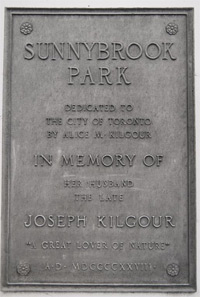
Alice M. Kilgour donates Sunnybrook Farm to the City of Toronto in memory of her husband Joseph Kilgour for use as a public park, to be known as Sunnybrook Park.
1942
The Greater Toronto Veterans’ Hospital Committee recommended Sunnybrook Park as the best location for a 1,590 bed veterans’ hospital. The consent of the Kilgour heirs was obtained.
November 11, 1943 - Sod Turning Ceremony
With the consent of the Kilgour heirs, 400 hectares of Sunnybrook Park, with the western boundary at Bayview Avenue, was transferred to the Government of Canada as the site for a new hospital for Canadian veterans.
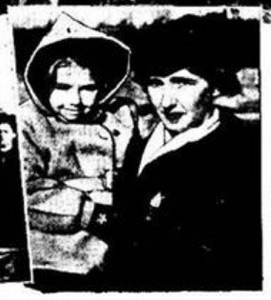
Pictured is Mrs. Esther Bailey, holding her five-year-old daughter, Kathleen, at the sod turning ceremony for the new Sunnybrook Hospital on November 11, 1943. Esther's husband, staff Sgt. Frank Bailey was killed on July 6, 1940 in a German bombing raid on a Canadian military camp in England. The camp's commanding officer informed Mrs. Bailey that her husband had become the first member of Canada's Active Army to lose his life in the war through enemy action.
September 26, 1946 - First patients transfer to Sunnybrook
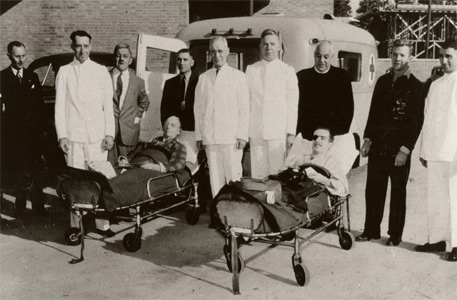
Pt Raymond Scott becomes the first patient to enter the Sunnybrook Military Hospital. He is part of a group of 100 patients transferred from the Christie Street Hospital. Patients lived in D-Wing, named Lancaster, named after the Bomber aircraft used in the Second World War.
January 30, 1947
The Red Cross Lodge opens at Sunnybrook. The Lodge was staffed by Canadian Red Cross Society volunteers who provided services and recreational activities until 2000.
June 12, 1948 - Official Opening
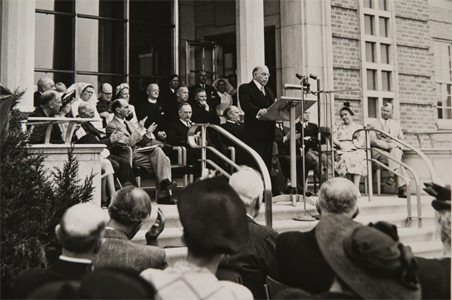
Sunnybrook Military Hospital is officially opened by the Right Honourable W.L. Mackenzie King, Prime Minister of Canada.
Hospital wings are named in "Ypres", "Ortona", and "Falaise" to honour the Royal Canadian Army, "Atlantic" to honour the Royal Canadian Navy, and "Lancaster" and "Spitfire" to honour the Royal Canadian Air Force.
Early 1950’s
The hospital opened the first clinical investigations unit in the city. By 1954, twenty-five projects were underway.
October 13, 1951
HRH Princess Elizabeth and Prince Philip visit Sunnybrook.
1952
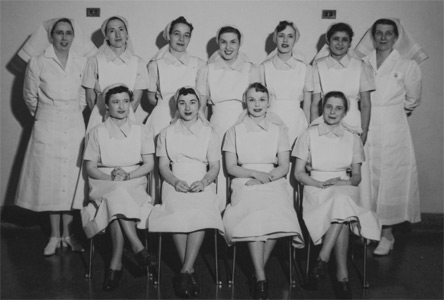
The first graduating class of nursing students at Sunnybrook receive their nursing caps.
1955
Co-founded by Dr. Charles S. Wright, who had a dream of a hospital dedicated to the care of patients with orthopaedic conditions, the Orthopaedic and Arthritic Hospital officially opened in 1955 with 14 beds ready for patients. It would later merge with Sunnybrook to become one of the finest programs of its kind in North America. Three generations of Wright orthopaedic surgeons have cared for patients. The hospital relocated to its current location in 1964, with an east wing added in 1974.
The facility is now known as the Holland Centre, a part of Sunnybrook’s Holland Bone and Joint Program. The Holland Centre represents the largest centre of excellence in Canada for hip and knee replacement surgery, and is a North American leader in bone and joint care, education and research. Its surgeons are pioneering a new generation of joint preservation surgery to improve mobility – just one example of innovative care.
June 30, 1959
HRH Queen Elizabeth II visits Sunnybrook.
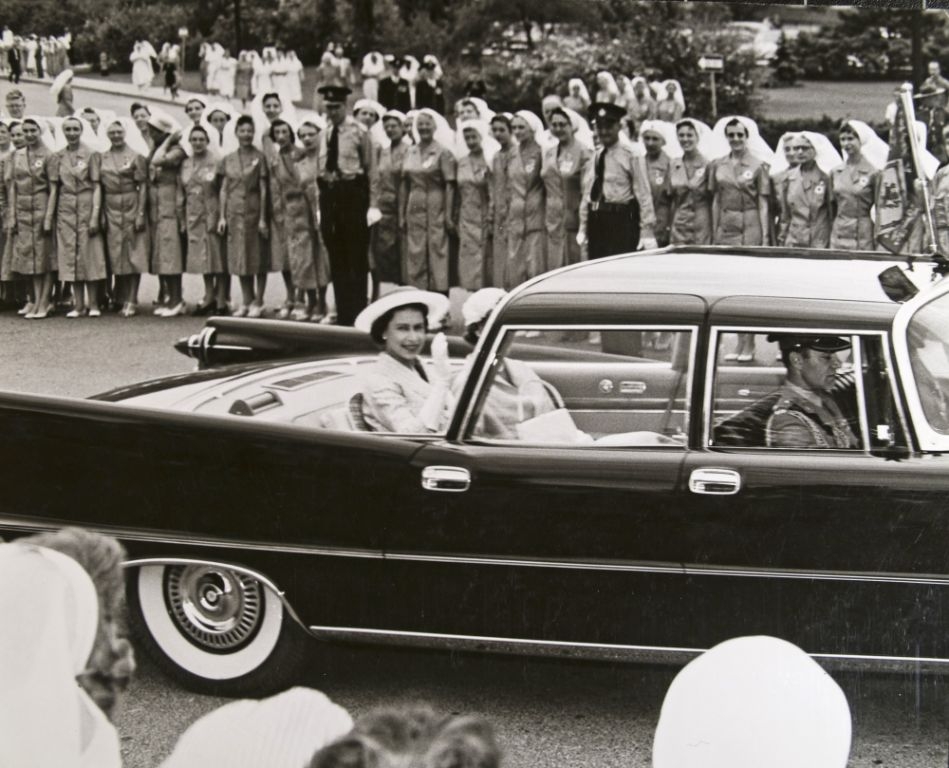
1966 to 1970
Sunnybrook was in transition during this time. A facilities development plan was re-evaluated and major renovations were undertaken to convert the hospital for acute care purposes. Renovations included clinical areas such as emergency, radiology, family practice, nursing units and service areas. New specialty services also were introduced including the Acute Spinal Cord Injury Unit and the MacLachlan Stroke Unit.
October 1, 1966
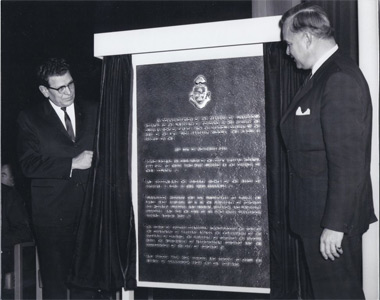
The Government of Canada transfers the administration of Sunnybrook to the University of Toronto for the cost of one silver dollar. Legislation titled The Sunnybrook Hospital Act officially changes the name of Sunnybrook Military Hospital to Sunnybrook Hospital. It becomes fully affiliated with the University of Toronto as a teaching hospital, serving the needs of both the veterans and general public.
1973
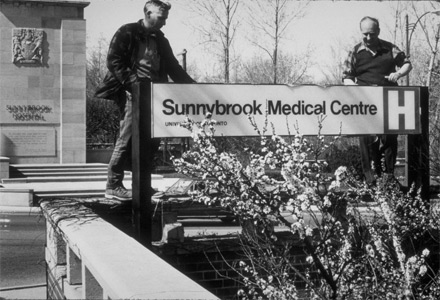
Sunnybrook Hospital becomes Sunnybrook Medical Centre.
The W.P. Scott Geriatric Day Hospital opened as Canada’s first freestanding geriatric day hospital. A new concept at the time, 10 patients a day would spend several hours receiving treatment and group therapy, returning to their homes in the late-afternoon. The goal of the program remains the same today as it was in 1973 – to provide comprehensive geriatric assessment, maximize an individual’s function and enable frail seniors to live independently in their own homes for as long as possible.
1976
Sunnybrook Medical Centre establishes Canada's first regional trauma unit to care for patients sustaining life-threatening multiple injuries.
Sunnybrook establishes Canada's first Stroke Care Unit.
The Kilgour Wing (K-Wing) officially opens as the new residence for Canadian veterans at Sunnybrook.
29 May 1977
Dame Vera Lynn visits the veterans at K-Wing.
1981
The Neuro-Doppler Laboratory at Sunnybrook was one of the first fully accredited cerebrovascular laboratories in Canada and one of the first ten centres in North America where transcranial Doppler was used. It is a great resource for training stroke and neurology experts from across North America and around the world.
The lab has seen giants in the field of stroke get their training here, including Dr. John Norris (the visionary who started the Neuro-Doppler Laboratory), Dr. Andrei Alexandrov (director of the University of Texas - Houston Medical School STAT neurosonology service) and Dr. Roberta Bondar (who learned the techniques here for application in space).
1982
Sunnybrook Medical Centre opens the Toronto-Bayview Regional Cancer Centre, an arm of the Ontario Cancer Treatment and Research Foundation. Since 2007 it has been known as the Odette Cancer Centre.
The Federal Government transferred its prosthetics unit to the hospital. The original mandate was to provide artificial limbs to war amputees both at the hospital and in Armed Forces Centres across Canada. Over the years the Prosthetic Services Centre earned an excellent reputation providing all types of innovative orthotic and prosthetic devices for veterans and the community.
1985
The Sunnybrook Aids-For-Living Centre officially opened as an outpatient facility to promote independent living and provide multi-faceted restorative services for disabled adults.
1986
The P.A.R.T.Y (Prevent Alcohol and Risk Related Trauma in Youth) Program is launched for youth aged fifteen and older. The program is a vital component of the growing community effort to reduce death and injury in alcohol, drug and risk-related crashes and incidents.
1989
Sunnybrook Medical Centre establishes a regional cardiovascular surgery and angioplasty centre now known as the Schulich Heart Centre.
Sunnybrook’s dedicated Palliative Care Unit opened in K-wing of the Veterans Centre with eight beds. At the time it was one of the first palliative care units in an academic health sciences centre in Ontario. Today, the unit has fifty-six beds and provides care for veterans or community patients with advanced disease.
January 1, 1990
The hospital formally changed its name to Sunnybrook Health Sciences Centre to recognize the increasing importance of health promotion and research, and to recognize all staff of the multi-disciplinary facility.
1990
Sunnybrook begins providing chronic care services to the community, building on the chronic and nursing home care program provided to veterans.
The George Hees Wing (L-Wing) officially opens and provides additional residential and health care services for veterans.
The Sunnybrook Aids-for-Living Centre was renamed the Sunnybrook Centre for Independent Living (SCIL).
1991
Sunnybrook opens major research facilities to house the rapid growth of research on campus.
1992
The Sunnybrook site was developed as a semi-autonomous campus of the University of Toronto. The first intake of undergraduate medical students to the “Sunnybrook Academy” takes place.
1994
Sunnybrook establishes the Boyd Academy of the University of Toronto to provide a focus for undergraduate medical education, including community agencies and partner institutions.
1998
Canada's largest centre for the treatment and care of burn injury, the Ross Tilley Burn Unit opens at Sunnybrook.
M-Wing officially opens.
June 24, 1998
The Government of Ontario's Bill 51 merges Sunnybrook Health Sciences Centre, Orthopaedic and Arthritic Hospital and Women's College Hospital to create Sunnybrook and Women's College Health Sciences Centre.
April 18, 2001
The Dorothy Macham Home opened providing innovative care and compassion for veterans with challenging behaviours due to dementia. The first facility of its kind in Canada, the ten bed unit was named in honour of Dorothy Macham, a member of the Nursing Sisters Association of Canada who was posted overseas in 1940 with the Royal Canadian Medical Corps. and served for six years from 1939 to 1945.
April 1, 2006
Sunnybrook Health Sciences Centre and Women's College Hospital end their amalgamation.
The Orthopaedic & Arthritic Institute (OAI) at Sunnybrook was renamed to recognize Susanne and William Holland's $20-million investment in the Holland Musculoskeletal Program and the OAI. Both the broader program and the facility’s names were changed to reflect this.
The Sunnybrook Branch of the Toronto Public Library celebrates 60 years at Sunnybrook.
September 12, 2010
Canada's largest gynaecological and obstetrics unit, the Women & Babies Program at Sunnybrook, opens.
2011
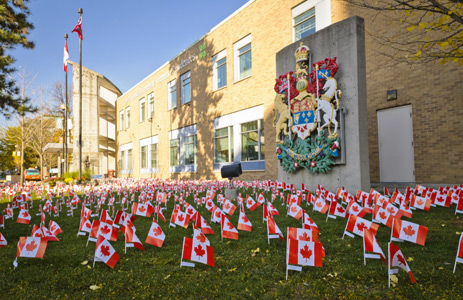
Sunnybrook launches the Operation Raise a Flag campaign to honour and support Canadian veterans. Proceeds from the campaign will go to the Veterans Comfort Fund at the Sunnybrook Veterans Centre. This fund provides veteran residents with things such as innovative equipment and computers, community outings, continued learning opportunities and musical instruments all in an effort to enable veterans to attain the best possible life experience while at Sunnybrook.
July 1, 2012
Sunnybrook Health Sciences Centre and St. John's Rehab Hospital voluntarily merge to create a more seamless continuum of health care from acute injury or illness, through to rehabilitation and recovery.
November 2012
Sunnybrook’s Rapid Diabetes Assessment & Referral (RADAR) Clinic opens. Patients with poorly controlled diabetes can benefit from intensive therapy in a single visit with a multidisciplinary team that includes endocrinologists, nurses, dietitians, and a nurse practitioner.
His Excellency the Right Honourable David Johnston opened the 150,000-aquare-foot Centre for Research in Image-Guided Therapeutics located on M6 and M7.
November 17, 2012
H.R.H. Princess Margriet of the Netherlands visited Sunnybrook Veterans Centre.
December 2012
Sunnybrook’s personal health record system, MyChart goes mobile allowing patients to access their personal health information by smart phone, iPad, or tablets.
2013
In a Canadian first, Sunnybrook brain scientist pioneered the use of MRI-guided focused ultrasound to successfully treat patients who suffer from deliberating tremors in their arms and hands. It is felt that this technology will have far-reaching implications for many brain conditions, including brain tumors, and other movement disorders.
May 2013
The Louise Temerty Breast Cancer Centre opened on M6 thanks to a $10-million gift from Louise and Jim Temerty. The Centre is home to expanded areas for specialized clinics, integrated breast imaging research and clinical trials.
September 21, 2013
The first RBC Run for the Kids was held in support of youth mental health and the Family Navigation Project within Sunnybrook’s youth psychiatry program.
October 29, 2013
Through a $10-million investment, The Slaight Family Foundation established The Slaight Centre for Image-Guided Brain Therapy and Repair at Sunnybrook. The centre is the site of the world’s first clinical trials using focused ultrasound to deliver therapy through the blood-brain barrier for dementia, stroke and brain tumours. At the core of the centre is a PET-MRI scanner, a fully integrated molecular imaging system that Sunnybrook Research Institute (SRI) scientists will combine with transcranial focused ultrasound – making it the only such system in the world.
February 2014
The Rapid Cardiology Assessment Clinic opened, providing rapid assessment for patients with heart failure.
October 15, 2014
Sunnybrook announces a state-of-the-art brain sciences centre, the first of its kind in Canada, thanks to a lead gift of $20 million from the Garry Hurvitz Foundation. The Garry Hurvitz Brain Sciences Centre will be home to an unprecedented approach to collaboration across disciplines, linking experts in each field of brain sciences – psychiatry, neurology, imaging, pharmacology, neuro-surgery, ophthalmology and geriatrics – in an effort to accelerate research and slow the progress of brain disorders. Track construction milestones.
November 2015
Though a groundbreaking clinical trial researchers at Sunnybrook made history with a new way of treating brain disease by successfully and safely opening the blood-brain barrier non-invasively, to test the ability to deliver chemotherapy directly into a patient’s brain tumour.
2017
Sunnybrook opens the new Accessible Care Pregnancy Clinic, the first North American clinic designed to provide specialized pregnancy care to women with physical mobility disabilities such as spinal cord injuries, severe arthritis, spina bifida, cerebral palsy, multiple sclerosis, chronic pain, muscular dystrophy, scoliosis, or trauma related to a car accident.
April 13, 2017
Sunnybrook and Michael Garron Hospital (MGH) formalized their collaboration to improve access to high-quality health-care services for all residents in their shared communities. The two organizations officially signed a Strategic Alliance Agreement signifying their commitment to working in partnership with one another and establishing a closer and more integrated relationship.
May 2017
Rick Karr is the first Alzheimer’s patient in the world to participate in a study that could forever change treatment of the disease. The phase 1 study used a technology called focused ultrasound to break through the blood-brain barrier, which is like a plastic wrap surrounding some areas of the brain. Breaking it open, temporarily offers a doorway to delivering medications directly and noninvasively to previously unreachable spots.
July 2017
Through a generous $10-million dollar donation by Toronto businessman Frederick Thompson (the largest in Canadian history for anxiety disorders) the Frederick W. Thompson Anxiety Disorders Centre opens. The Centre offers specific expertise in the treatment of obsessive-compulsive disorder (OCD) and related “spectrum” disorders, including hoarding, hair pulling, skin picking and body dysmorphic disorders for anyone over the age of 18.
January 25, 2020
When Canada’s first case of the novel coronavirus, COVID-19, was confirmed in a patient at Sunnybrook on January 25, 2020, the hospital was preparing for a potential pandemic. Sunnybrook’s teams worked tirelessly through stress, fear, uncertainty and a fundamental shift in the way health care is delivered. Take a look inside Sunnybrook’s pandemic response.
April - September 2021
The Mobile Health Unit (MHU) at Sunnybrook was constructed in the spring of 2021, drawing wide attention as the pandemic folded into its second year. Measuring 2,088 square metres (22,475 square feet) and equipped with 84 beds, it was used to care for patients who were recovering from or had recovered from COVID-19. During its four months of active operation, 32 patients from around the GTA were cared for in the Mobile Health Unit. The teams tasked with the immense responsibility of planning the MHU and providing patient care were predominantly made up of women. Some of those involved share their thoughts on what the experience was like for them.





